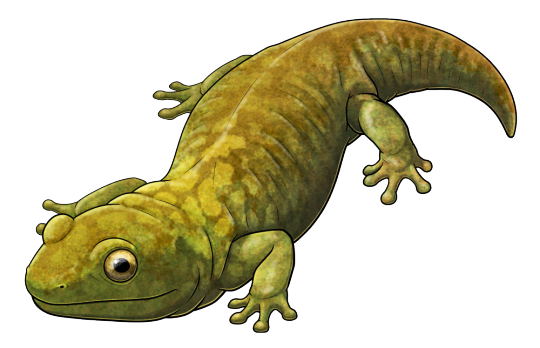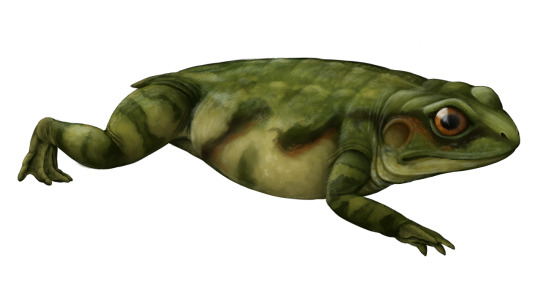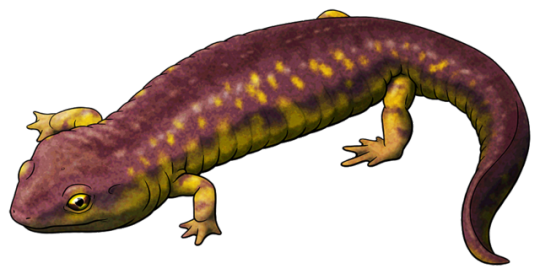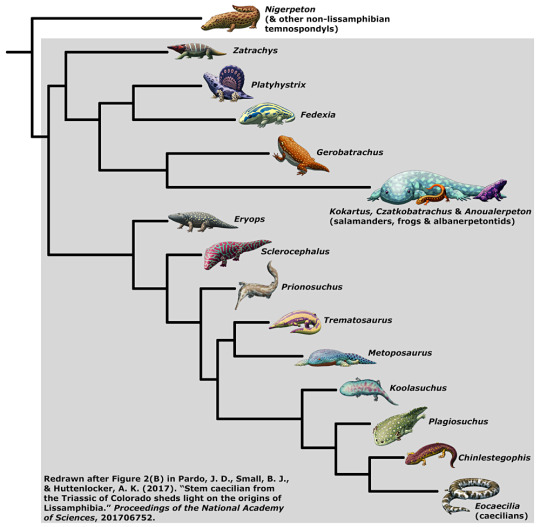#stem-lissamphibian
Text

Despite being named after the famous Muppet frog, Kermitops gratus here wasn't actually a frog itself. Instead it was a close relative of the common ancestor of all modern amphibians, part of a grouping of amphibian-like animals known as amphibamiform temnospondyls.
Living in what is now Texas, USA, during the mid-Permian, about 275 million years ago, Kermitops would have resembled a chunky salamander. Only its fossil skull is known, so its full body size is uncertain, but based on the proportions of related amphibamiformes it was probably around 15-20cm long (~6-8").
Although its discovery helps to fill in the very sparse fossil record of the early evolution of modern amphibians, it's also complicated matters more than expected. Previously it was thought that the characteristic skull anatomy of modern amphibians evolved in a clear sequence, but Kermitops has a unique mix of features that doesn't fit this idea – suggesting that there was a lot of convergent evolution going on in amphibamiformes at the time.
———
NixIllustration.com | Tumblr | Patreon
#science illustration#paleontology#paleoart#palaeoblr#kermitops#amphibamiformes#dissorophoidea#temnospondyl#amphibian#stem-lissamphibian#tetrapod#art#it's not easy bein' green#somebody name an entelodont after miss piggy next please
364 notes
·
View notes
Photo

Triassic stem caecilian supports dissorophoid origin of living amphibians
Ben T. Kligman, Bryan M. Gee, Adam D. Marsh, Sterling J. Nesbitt, Matthew E. Smith, William G. Parker & Michelle R. Stocker
Abstract
Living amphibians (Lissamphibia) include frogs and salamanders (Batrachia) and the limbless worm-like caecilians (Gymnophiona).
The estimated Palaeozoic era gymnophionan–batrachian molecular divergence suggests a major gap in the record of crown lissamphibians prior to their earliest fossil occurrences in the Triassic period.
Recent studies find a monophyletic Batrachia within dissorophoid temnospondyls, but the absence of pre-Jurassic period caecilian fossils has made their relationships to batrachians and affinities to Palaeozoic tetrapods controversial.
Here we report the geologically oldest stem caecilian—a crown lissamphibian from the Late Triassic epoch of Arizona, USA—extending the caecilian record by around 35 million years. These fossils illuminate the tempo and mode of early caecilian morphological and functional evolution, demonstrating a delayed acquisition of musculoskeletal features associated with fossoriality in living caecilians, including the dual jaw closure mechanism, reduced orbits and the tentacular organ.
The provenance of these fossils suggests a Pangaean equatorial origin for caecilians, implying that living caecilian biogeography reflects conserved aspects of caecilian function and physiology, in combination with vicariance patterns driven by plate tectonics.
These fossils reveal a combination of features that is unique to caecilians alongside features that are shared with batrachian and dissorophoid temnospondyls, providing new and compelling evidence supporting a single origin of living amphibians within dissorophoid temnospondyls.
Read the paper here:
https://www.nature.com/articles/s41586-022-05646-5
6 notes
·
View notes
Text
Triadobatrachus massinoti

By Scott Reid
Etymology: Triassic frog
First Described By: Piveteau, 1936
Classification: Biota, Archaea, Proteoarchaeota, Asgardarchaeota, Eukaryota, Neokaryota, Scotokaryota Opimoda, Podiata, Amorphea, Obazoa, Opisthokonta, Holozoa, Filozoa, Choanozoa, Animalia, Eumetazoa, Parahoxozoa, Bilateria, Nephrozoa, Deuterostomia, Chordata, Olfactores, Vertebrata, Craniata, Gnathostomata, Eugnathostomata, Osteichthyes, Sarcopterygii, Rhipidistia, Tetrapodomorpha, Eotetrapodiformes, Elpistostegalia, Stegocephalia, Temnospondyli, Euskelia, Dissorophoidea, Xerodromes, Amphibamiformes, Lissamphibia, Batrachia, Salientia, Triadobatrachidae
Referred Species: T. massinoti
Status: Extinct
Time and Place: Approximately 251–250 million years ago, in the late Induan to early Olenekian of the Early Triassic.

Triadobatrachus is only known from the Sakamena Formation in Northern Madagascar.

Physical Description: Triadobatrachus superficially resembles modern frogs, it was only around 10 cm long, had a broad head and a very reduced tail. Its skeleton had many features associated only with frogs among amphibians, including a very frog-like skull with big eyes and their characteristically elongated hips. Soft tissues preserved around the fossil even show that it had the wide, round body of frogs too. However, the skeleton of Triadobatrachus differed from living frogs in a few major ways. It had much more vertebrae than living frogs, 26 compared to the maximum 4–9 of frogs alive today, giving it a much longer body, and these vertebrae had ribs, unlike living frogs. Its legs were shorter and more squat, especially its back legs, which were hardly any longer than its front ones, making Triadobatrachus incapable of hopping despite its derived hips. Even the stumpy tail was still more prominent than in living frogs, and may have even retained some degree of mobility. To sum it up, Triadobatrachus more or less looked like a stretched out frog with short legs. Think of a horned toad lizard but with more of the toad part and less horned.
Diet: Like other frogs, Triadobatrachus was probably carnivorous, likely feeding on invertebrates like insects and other arthropods, molluscs, worms, and perhaps even any small vertebrates it could fit in its mouth.
Behavior: One of the most standout features of Triadobatrachus is that it couldn’t have hopped like modern frogs. Instead, Triadobatrachus would have walked around on land more like a salamander, although it is unknown just how much time it would have spent on land in the first place anyway. It was clearly amphibious, and it probably swam by kicking its back legs like frogs, unlike the undulation of newts and salamanders. It would have spawned like living amphibians too, laying shell-less eggs in water that hatched into tadpoles and underwent metamorphosis just like modern frogs. Otherwise, its behaviour is a mystery. We don’t even know if it would have croaked or not.
Ecosystem: Not much is directly known about the ecosystem Triadobatrachus inhabited, as the only known fossil had been washed out to sea along the coast. The intact body at least implies the body wasn’t transported far, so Triadobatrachus probably lived in coastal floodplain rivers and swamps. Various other temnospondyl amphibians are known from the area, including Edingeralla, Deltacephalus, Mahavisaurus, Wantzsosaurus and Tertremoides. Despite being amphibians, many of these temnospondyls were likely euryhaline, meaning they could tolerate salt water and inhabited the coastline, something only a few living amphibians are even remotely capable of standing. The peculiar aquatic reptile Hovasaurus lived along the coasts, although it’s unknown if it ever crossed paths with the freshwater frogs, and terrestrial procolophonid parareptiles were also present. Plant remains suggest the environment was tropical and semi-arid with a monsoonal climate that supported conifer forests along with seed ferns, horsetails and clubmosses.
Other: Triadobatrachus is one of the only known stem-frogs, along with the polish Czatkobatrachus, and is certainly the oldest. The early evolution of Lissamphibia (all living amphibians) is poorly understood, particularly whether their ancestry lies in the temnospondyls or some other “amphibians”. Triadobatrachus doesn’t solve this debate, although it does show similarities to the Permian amphibamiforms like Gerobatrachus, supporting the temnospondyl affinity for batrachians (the frogs and salamanders) amongst dissorophoids.
Before they were considered to be temnospondyls, lissamphibians were often thought to be lepospondyls, a probably paraphyletic or even polyphyletic (i.e. unnatural) collection of “amphibians” on the tetrapod tree more derived than temnospondyls (some may even be honest to goodness amniotes!). This picture is complicated by caecilians, which at one point were suggested to be lepospondyls while batrachians were temnospondyls, making Lissamphibia polyphyletic! The story got even stranger after a little Triassic amphibian, Chinlestegophis, was discovered in 2017 and was considered to be a stem-caecilian. Chinlestegophis pulled caecilians back into temnospondyls with the other lissamphibians, but at almost opposite ends of the temnospondyl tree—batrachians in amphibamiforms and caecilians in with the stereospondyls related to the giant metoposaurs! So lissamphibians may all be temnospondyls...but also polyphyletic, unless nearly all of Temnospondyli is classed as lissamphibians and becomes part of the crown group. This would also mean our small modern amphibians both independently miniaturised from the much larger, classic predatory amphibians of the Palaeozoic and Triassic. What a concept.
Regardless of temnospondyl taxonomic troubles, Triadobatrachus is a perfect transitional form from more generalised amphibians to the highly specialised anatomy of frogs. Particularly, it shows that some of their unique anatomical adaptations evolved before they were able to hop, and may have functioned for other activities like swimming. The almost complete preservation of a skeleton as delicate as one of a small amphibian is a remarkable find, let alone one that represents a perfect transitional form for a group of animals whose evolutionary history is shrouded in mystery, and makes Triadobatrachus a fantastic find, no matter how unassuming it may be.
~ By Scott Reid
Sources under the Cut
Ascarrunz, Eduardo; Rage, Jean-Claude; Legreneur, Pierre; Laurin, Michel (2016). "Triadobatrachus massinoti, the earliest known lissamphibian (Vertebrata: Tetrapoda) re-examined by µCT-Scan, and the evolution of trunk length in batrachians". Contributions to Zoology. 58 (2): 201–234.
Lires, A. I., Soto, I. M., & Gómez, R. O. (2016). Walk before you jump: new insights on early frog locomotion from the oldest known salientian. Paleobiology, 42(4), 612-623.
Maganuco, S., Steyer, J.S., Pasini, G., Boulay, M., Lorrain, S., Bénéteau, A., Auditore, M. (2009). “An exquisite specimen of Edingerella madagascarensis (Temnospondyli) from the Lower Triassic of NW Madagascar; cranial anatomy, phylogeny, and restorations”. Società italiana di scienze naturali.
Pardo, Jason D.; Small, Bryan J.; Huttenlocker, Adam K. (2017-07-03). "Stem caecilian from the Triassic of Colorado sheds light on the origins of Lissamphibia". Proceedings of the National Academy of Sciences. 114 (27): E5389–E5395
Piveteau, J. (1936). "Une forme ancestrale des amphibiens anoures dans le Trias inférieur de Madagascar". Comptes Rendus Hebdomadaires des Séances de l'Académie des Sciences. 202: 1607–1608.
Rage,J-C; Roček, Z. (1989). "Redescription of Triadobatrachus massinoti (Piveteau, 1936) an anuran amphibian from the Early Triassic". Palaeontographica Abteilung A. 206: 1–16.
Roček , Z., Rage, J-C. (2000). "13. Proanuran Stages (Triadobatrachus, Czatkobatrachus)". In Heatwole, H.; Carroll, R. L. (eds.). Amphibian Biology. Paleontology: The Evolutionary History of Amphibians. 4. Surrey Beatty & Sons. pp. 1284–1294.
Ročková, H., Roček Z. (2005). “Development of the pelvis and posterior part of the vertebral column in the Anura”. Journal of Anatomy. 206(1): 17–35.
Xing, L., Stanley, E. L., Bai, M., & Blackburn, D. C. (2018). “The earliest direct evidence of frogs in wet tropical forests from Cretaceous Burmese amber”. Scientific reports, 8(1), 8770.
#Triadobatrachus#Triadobatrachus massinoti#Frog#Palaeoblr#Triassic Madness#Triassic March Madness#Triassic#Prehistory#Paleontology#Prehistoric life
158 notes
·
View notes
Photo

The newly-named Chinlestegophis jenkinsi, in the style of last year’s Amphibian August illustrations.
Living during the Late Triassic of Colorado, USA, (~220 mya), this 30cm long (1′) amphibian had a skull showing a mixture of features shared with both temnospondyls and modern caecilians -- providing a vital “missing link” in their evolutionary history. Previously the oldest known caecilian-relative was the Jurassic-aged Eocaecilia, which already had much more modified anatomy making it harder to definitively link to other known groups.
Chinlestegophis seems to have been part of the stereospondyl branch of the temnospondyls -- and an unexpected side effect of adding caecilians into this group is that many temnospondyls could now potentially also be classified as true members of Lissamphibia.

An example family tree showing this new version of amphibian relationships. If we define Lissamphibia as including all living amphibians and their extinct relatives back to their last shared common ancestor, then everything within the grey box is a lissamphibian!
Of course, this is still just one hypothesis of amphibian evolution among several other competing ideas. Maybe it’s right, maybe it isn’t -- as always, we need more fossil evidence! -- but it’s certainly an interesting and surprising new development in the ongoing saga of “what are lissamphibians? we just don’t know”
2023 Update: …But the discovery of Funcusvermis suggests Chinlestegophis isn't a caecilian at all, but instead an unrelated case of convergent evolution!
#science illustration#paleontology#paleoart#palaeoblr#chinlestegophis#chinlestegophis jenkinsi#stem-caecilian#caecilian#stereospondylomorpha#temnospondyl#amphibian#lissamphibia#transitional forms#what are lissamphibians? we just don't know#art
252 notes
·
View notes